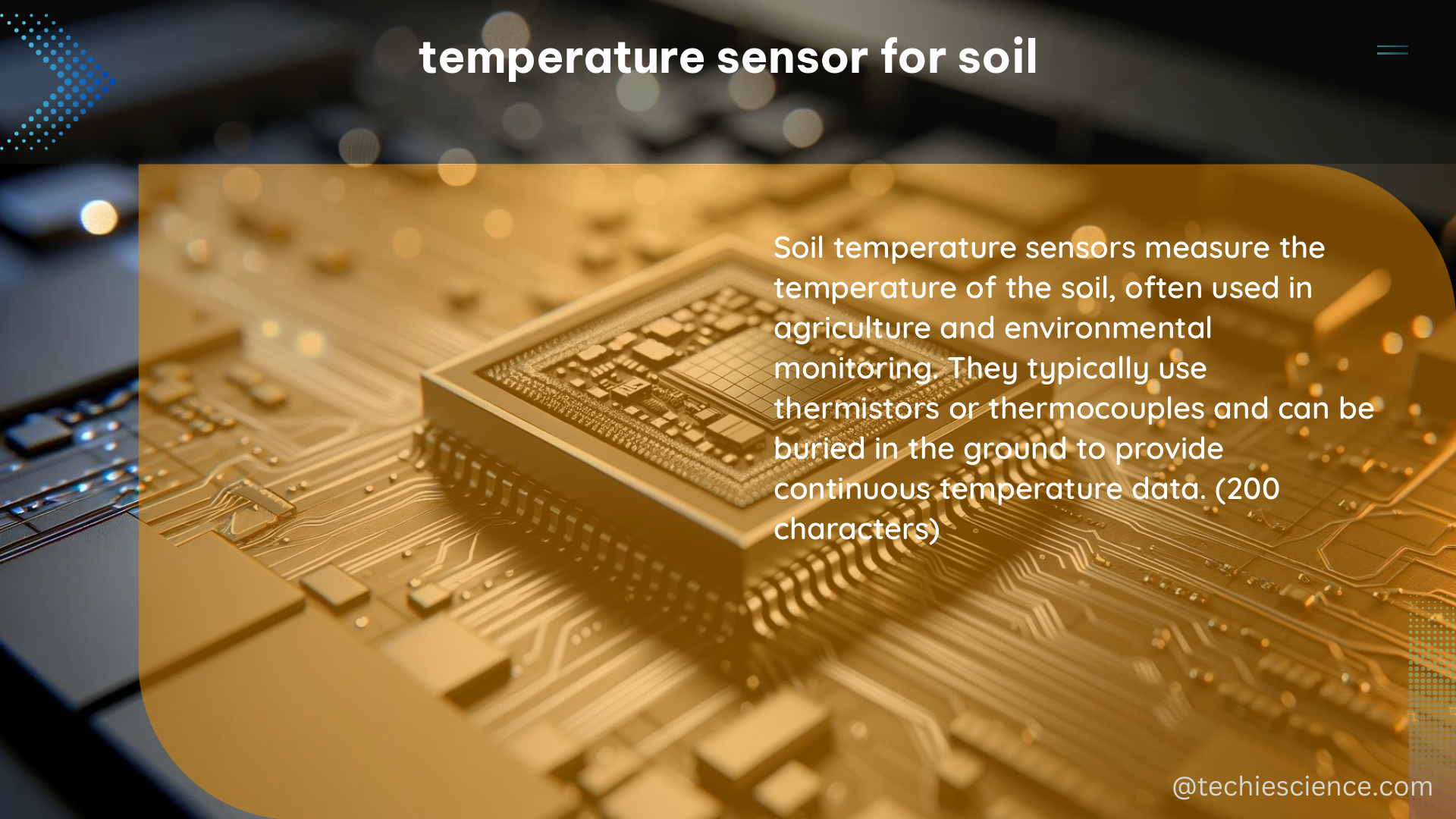Soil temperature is a crucial factor that affects various processes within the soil, such as chemical reactions, organic matter decomposition, microbial activity, and seed germination. Accurate soil temperature monitoring is essential in agriculture, horticulture, and meteorology. This comprehensive guide will delve into the technical details of two popular soil temperature sensors, the Vegetronix THERM200 and the Campbell Scientific CS655, as well as provide insights into creating a DIY temperature sensor using an Arduino.
Vegetronix THERM200 Soil Temperature Sensor
The Vegetronix THERM200 is a rugged and waterproof soil temperature sensor probe designed to withstand the harsh conditions of the soil environment. Constructed with durable ABS plastic and fiberglass, the sensor features a thin blade that minimizes root damage during installation. The THERM200 can measure temperatures ranging from -40°C to 85°C, with an output signal that varies linearly from 0V at -40°C to 3V at 85°C.
Key Specifications:
– Measurement Range: -40°C to 85°C
– Output Signal: 0 to 3V
– Sensor Material: ABS plastic and fiberglass
– Probe Design: Thin blade to prevent root damage
– Thermal Mass: High due to waterproof enclosure, which can result in a 15-minute or more settling time after rapid external temperature changes
The Vegetronix THERM200’s high thermal mass is a result of its waterproof enclosure, which helps protect the sensor from the harsh soil environment. However, this also means that the sensor may take longer to stabilize after experiencing a rapid change in external temperature, typically around 15 minutes or more.
Campbell Scientific CS655 Soil Moisture and Temperature Sensor

The Campbell Scientific CS655 is a multiparameter smart sensor that not only measures soil temperature but also provides data on soil volumetric water content and bulk electrical conductivity. This sensor utilizes innovative techniques to derive these soil properties from the raw measurements of propagation time, signal attenuation, and temperature.
Key Specifications:
– Measurement Range: -50°C to +70°C for soil temperature
– Output Signal: SDI-12 or serial RS-232
– Sensor Design: Two 12-cm-long stainless steel rods connected to a printed circuit board, with a shielded cable for data logger connection
– Sensing Volume: 3600 cm³ (approximately 7.5 cm radius around each probe rod and 4.5 cm beyond the end of the rods)
– Compliance: CE compliant, meeting EN61326 requirements for protection against electrostatic discharge and surge
The CS655’s sensing volume of 3600 cm³ allows it to capture a larger area of the soil, providing a more representative measurement of the soil temperature compared to sensors with a smaller sensing volume. Additionally, the sensor’s compliance with EN61326 standards ensures its reliability and durability in the field.
DIY Temperature Sensor for Soil using Arduino
For those interested in creating a DIY soil temperature sensor, the Arduino platform is an excellent choice. These small, inexpensive microcontrollers can be used to interface with various temperature sensors and collect data, which can then be transmitted to an online service for aggregation and analysis.
When building a DIY soil temperature sensor with an Arduino, you can choose from a variety of temperature sensor options, such as:
-
Thermistor: A thermistor is a temperature-sensitive resistor that changes its resistance in response to temperature changes. Thermistors are inexpensive and can provide accurate temperature measurements, but they require calibration to ensure reliable readings.
-
Dallas DS18B20 Digital Temperature Sensor: The DS18B20 is a digital temperature sensor that communicates using the 1-Wire protocol. It offers a temperature measurement range of -55°C to +125°C with an accuracy of ±0.5°C, making it a popular choice for DIY soil temperature monitoring projects.
-
Analog Temperature Sensors: Analog temperature sensors, such as the LM35 or TMP36, provide a voltage output that varies linearly with temperature. These sensors are easy to interface with an Arduino and can provide accurate temperature measurements.
When designing a DIY soil temperature sensor, consider factors such as sensor placement, data logging, and power management to ensure reliable and long-lasting performance in the field.
References
- Vegetronix THERM200 Soil Temperature Sensor Probes
- Soil Temperature Sensors: Thermocouples and thermistors – Campbell Scientific
- CS655: 12 cm Soil Moisture and Temperature Sensor – Campbell Scientific
- STP01 soil temperature sensor – Hukseflux
- Soil Temperature Monitoring – Part One – Chris Ramsay

The lambdageeks.com Core SME Team is a group of experienced subject matter experts from diverse scientific and technical fields including Physics, Chemistry, Technology,Electronics & Electrical Engineering, Automotive, Mechanical Engineering. Our team collaborates to create high-quality, well-researched articles on a wide range of science and technology topics for the lambdageeks.com website.
All Our Senior SME are having more than 7 Years of experience in the respective fields . They are either Working Industry Professionals or assocaited With different Universities. Refer Our Authors Page to get to know About our Core SMEs.